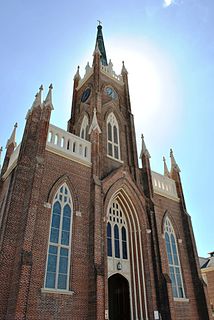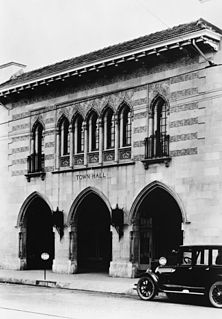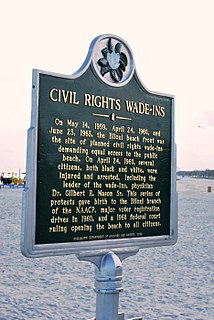Related Research Articles

Biloxi is a city in and one of two county seats of Harrison County, Mississippi, United States. The 2010 United States Census recorded the population as 44,054, and in 2019 the estimated population was 46,212. The area's first European settlers were French colonists.

Ocean Springs is a city in Jackson County, Mississippi, United States, approximately 2 miles (3.2 km) east of Biloxi and west of Gautier. It is part of the Pascagoula, Mississippi Metropolitan Statistical Area. The population was 17,225 at the 2000 U.S. Census. As of the 2010 U.S. Census, the city of Ocean Springs had a population of 17,442.

George Edgar Ohr was an American ceramic artist and the self-proclaimed "Mad Potter of Biloxi" in Mississippi. In recognition of his innovative experimentation with modern clay forms from 1880–1910, some consider him a precursor to the American Abstract-Expressionism movement.

The Mississippi Gulf Coast, also known as the Mississippi Gulf Coast region, Coastal Mississippi, or simply The Coast, is the area of southern Mississippi along the Mississippi Sound along the Gulf of Mexico.

The Roman Catholic Diocese of Jackson is a diocese in the ecclesiastical province of Mobile, in the southern United States of America. Its ecclesiastical jurisdiction includes the northern and central parts of the state of Mississippi, an area of 97,458 square kilometers (37,629 sq mi). It is the largest diocese, by area, east of the Mississippi River in the United States.

The Diocese of Natchez was the predecessor of the Roman Catholic Diocese of Jackson. It served all of Mississippi until the state was split into two dioceses, Jackson and Biloxi. The cathedral in Natchez, Mississippi is now a minor basilica and has retained much of its historical architectural splendor.

Joseph Lawson E. Howze was an African-American prelate of the Roman Catholic Church. He served as the first Bishop of Biloxi from 1977 to 2001, and was the first openly Black Catholic bishop of a diocese.
Biloxi High School is the only public high school located in the city of Biloxi, Mississippi. It has approximately 1,650 students and 150 faculty.

Sacred Heart High School is a Roman Catholic parochial school in the historic district of downtown Hattiesburg, Mississippi where it is mostly surrounded by Victorian-era homes and other churches. It is the only High School in the Northern Deanery of the Roman Catholic Diocese of Biloxi.

Jules Jacques Benois Benedict was one of the most prominent architects in Colorado history, whose works include a number of well-known landmarks and buildings listed on the National Register of Historic Places.

The Margaritaville Casino and Restaurant is a closed casino and restaurant in Biloxi, Mississippi in the United States. The 68,000-square-foot (6,300 m2) property is in the "Back Bay" area of Biloxi. It opened on May 22, 2012 and closed on September 15, 2014. Its brand was licensed from Jimmy Buffett's Margaritaville.

The Ohr-O'Keefe Museum Of Art is a non-profit art museum located in Biloxi, Mississippi, dedicated to the ceramics of George E. Ohr, the self-proclaimed "Mad Potter of Biloxi". The museum is named for ceramic artist George E. Ohr (1857–1918), as well as Annette O'Keefe, late wife of former Biloxi mayor Jeremiah O'Keefe, Sr., who was instrumental in donating money and raising funds for the completion of the museum campus.

Jeremiah Joseph "Jerry" O'Keefe III was an American World War II veteran and decorated fighter pilot ace. In addition, he served as a member of the Mississippi House of Representatives and was the mayor of Biloxi, Mississippi from 1973 to 1981.

Theodore "Theo" Brune was a German-American architect in Biloxi, Mississippi. He designed many churches on the Gulf Coast of Louisiana and in Mississippi including the Cathedral of the Nativity of the Blessed Virgin Mary at 870 West Howard Avenue in Biloxi.

The Biloxi wade-ins refers to three protests that were conducted by local African Americans on the beaches of Biloxi, Mississippi between 1959 and 1963, during the civil rights movement. The demonstrations were led by Dr. Gilbert R. Mason, Sr. in an effort to desegregate the city's 26 mi (42 km) of beaches on the Mississippi Gulf Coast. This was a local effort, without involvement from the state or national NAACP.
Dusti Bongé was an American painter who worked from the 1930s through the early 1990s. She is considered Mississippi's first Abstract Expressionist painter and its first Modernist artist.

Gilbert R. Mason Sr., was a physician who was a family practitioner and civil rights leader in Biloxi, Mississippi. He is noted for organizing three wade-ins, from 1959 to 1963, to desegregate the city's public beaches, which had been made with federal funds. This was the first nonviolent civil disobedience action conducted in Mississippi in the 1950s.
Mabel Marks Bacon was an American hotelier. She designed and operated several prominent hotels along the Gulf Coast in the 1930s. In the 1910s she was known for her skill with sailing, skippered a portion of a race from New York to Bermuda in 1910, and learned to drive in 1911. She raised her children in Maine and Panama, where the family lived while her husband was employed by the Panama Canal Company. In 1921, after returning to the United States, she ran a hotel known as the Inn-by-the-Sea in Pass Christian, Mississippi, which was a luxury resort built by her husband. Losing the hotel during the Great Depression, the family lived on board a boat for several months before landing at Dauphin Island, Alabama. Leasing the abandoned Fort Gaines from the government, they ran The-Sea-Fort-Inn until they discovered property while sailing along the Santa Rosa Sound. In 1935, they moved to Mary Esther, Florida, where Bacon designed and ran Bacon's-by-the-Sea. The hotel was frequented by several movie production companies and stars and was listed in 1954 as one of the top ten hotels in America in Look.
References
- 1 2 Henry Francis Fountain Jr. Biloxi Historical Society by Ray L. Bellande
- ↑ The Sun Herald, June 7, 2011, p. A4
- ↑ The Sun Herald, June 7, 2011, p. A4 and Harrison Co., Mississippi Circuit Court MRB 82, p. 142